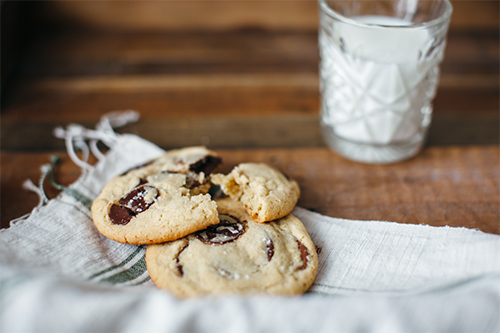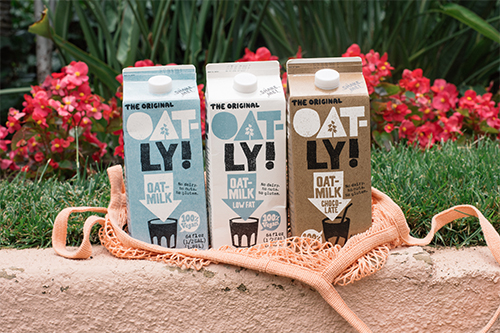The dawn of a new year has long been a time for forecasts and prophecies, for both trendspotters and laymen alike. For starters, everyone wants a jump start on the hottest fashions, the colors of the year, sports team rankings, and the future state of the economy. All valid concerns, but of course my area of interest swings toward food and drink. After scouring websites, restaurants, magazines, and social media, here are my predictions for what we’ll be seeing a lot of in restaurants, supermarkets, and specialty food stores in the coming months. (Please note that I am focusing on food and drink that we will actually be consuming; I will not concern myself with Instagrammable food that is meant to be virally photogenic, but not necessarily eaten.)
1. Tahini Desserts
Tahini, the magic ingredient of Middle Eastern cooking, is making inroads onto the dessert menu. For some, it’s a way around peanut butter as an ingredient. According to Amy Emberling, a partner at Ann Arbor, Michigan’s fabulous Zingerman’s Bakehouse, peanuts are an allergen they can easily bake without, and sesame-rich tahini is a great substitute in cookies, cakes, and pastries. For others, it’s an obsession. The Food Network’s Molly Yeh (“Girl Meets Farm“) is a huge proponent of sesame and halvah (a sesame confection) usage in her baking, as she freely admits on her popular food blog, My Name is Yeh, where she uses them in everything from milkshakes and caramel apples, to chocolate chip cookies and buttercream.

2. Non-Dairy “Mylks”
You don’t have to be a vegan to enjoy non-dairy “mylks,” as the proliferation of current marketplace options makes abundantly clear. Milk substitutes, once an often hard-to-find necessity for those with dairy allergies, will continue to grow as a category. Soy, almond, and coconut milks are now mainstream (hello, Starbucks!), but oat, cashew, hazelnut, and macadamia are showing strong too. Summer 2018 even saw an oat milk shortage, causing prices for the precious commodity to skyrocket. Oatly, a Swedish oat milk that many feel is the best on the market, couldn’t keep up with the demand, and Brooklyn collectively swooned. The dairy industry has taken notice.

3. Vegan “Meat”
Often called “mock meats,” vegan meat substitutes have gained plenty of ground in the past year. Along with a growing interest in healthier, plant-based diets (think flexitarian as well as vegetarian and vegan), this is at least partially due to recent entrants in the ever-popular veggie-burger category. Goodbye, hockey puck-like Boca Burgers and the like! Who needs you when we’ve got the widely available, soy- and gluten-free Beyond Burger, that bleeds real blood … er, actually, beet juice. These plant-based burger patties have a whopping 20 grams of protein per serving and they griddle up beautifully. But the true taste and texture prizewinner in my book in this category is the Impossible™ Burger — at least if you’re looking for a meat substitute that really tastes like a classic hamburger. Now available at select restaurants around the country, it’s trying to make its way to grocery store shelves this year, though it’s been facing some regulatory hurdles with the FDA (though not for any reasons Impossible devotees should lose sleep over). The burger is manufactured by Impossible Foods, a California company with a mission to make our food systems more sustainable and produce less of a carbon footprint.
Chef Amber Lancaster of Chicago’s Sable Kitchen & Bar is actively trying to work more plant-based proteins onto her menu. “It’s truly confusing because it tastes so much like red meat,” says Lancaster of the Impossible Burger, which she griddles and serves on a sesame-topped brioche bun slathered with aioli, smoked-onion marmalade, spicy bread & butter pickles, arugula, and a very un-vegan swath of melty raclette cheese.

4. Chinese Hot Pot
Watch your back, ramen. This interactive Chinese cooking method is gaining ground around the world. A simmering pot of rich stock is set over a heat element on the dining table, and prepared ingredients — thin slices or small pieces of protein, green leafy veggies, noodles, bean sprouts, daikon, mushrooms, scallions, herbs, etc. — are added in at the whim of the diners. It’s a bonding as well as gastronomic experience (a la fondue), and it’s relatively inexpensive to boot.
5. Heritage Grains
Carbs fights back! People with gluten sensitivity are finding that heritage and ancient grains (including spelt, teff, freekeh, and older wheat varietals) are more easily digestible, and farmers know that they are naturally drought- and pest-resistant. Whole grains, which retain the germ and are far less processed than white flour, rice, etc., are a great source of fiber. Plus, they just taste better, dammit. So good, and good for you? Yes, please. Bakers around the country are finding that people are warming to whole-grain breads and pastries, especially when educated about the health benefits. Ellen King, owner of Hewn Bakery in Evanston, Illinois, and author of “Heritage Baking: Recipes for Rustic Breads and Pastries Baked with Artisanal Flour from Hewn Bakery,” has gone a step further, partnering with local farmers to resuscitate heritage grains — and local millers to stone-grind them — which she then uses in her freshly baked sourdough loaves.
It’s not just bakers that are touting heritage and whole grains. Restaurants from health-conscious fast casual (hello, Le Pain Quotidien’s Sunny Side Breakfast Bowl with Ancient Grains) and critics’ darlings (Los Angeles’ Sqirl serves its Traditional Kokuho Rose Brown Rice Porridge with organic milk, toasted hazelnuts, and house-made jam) to James Beard Award winners: The menu at Seattle chef Edouardo Jordan’s newest restaurant, Lucinda Grain Bar, due to open in early 2019, will feature grains like buckwheat, millet, and wheat berries in nearly every dish. If this two-time JBA winner doesn’t have his finger on the pulse, who does?
6. Mocktails
January, long a time of abstention, resolutions, and fresh starts, is also now known as “Dryuary,” a month-long detox from the excesses of the holiday season. Restaurants are taking notice of the trend and rising to the occasion with tasty and enticing beverages that won’t knock you for a loop. No need to revert to ye olde Shirley Temple with its neon-bright cherry plopped in a sea of sickly-sweet liquid. Instead, you could be enjoying a kombucha-based beverage like this Sparkling Cranberry Kombucha Mocktail or a Mango Mule or Rosemary Blueberry Smash.
Access to fresh juices, myriad local brands producing creative bitters (I am especially partial to Fee Brothers’ Rhubarb), and flavor-infused simple syrups are fueling this trend. Seedlip, a newish British beverage company that bills themselves as “the world’s first distilled non-alcoholic spirits,” has also added to the mocktail convo with three signature flavors: aromatic Spice 94, herbaceous Garden 108, and citrusy Grove 42. Just the thing when your liver needs time to de-pickle but you want something a little more adventurous than club soda with lime.
More from Make It Better:
- How to Build the Perfect Cheese Board
- 8 of the Best Clean Eating Accounts to Follow on Instagram
- 2 Can’t-Miss Foodie Events Bring Chicago’s Top Chefs and Restaurants Together for a Great Cause
 Julie Chernoff, Make It Better’s dining editor since its inception in 2007, graduated from Yale University with a degree in English — which she speaks fluently — and added a professional chef’s degree from the California Culinary Academy. She has worked for Boz Scaggs, Rick Bayless, and Wolfgang Puck (not all at the same time); and sits on the boards of Les Dames d’Escoffier International and Northlight Theatre.
Julie Chernoff, Make It Better’s dining editor since its inception in 2007, graduated from Yale University with a degree in English — which she speaks fluently — and added a professional chef’s degree from the California Culinary Academy. She has worked for Boz Scaggs, Rick Bayless, and Wolfgang Puck (not all at the same time); and sits on the boards of Les Dames d’Escoffier International and Northlight Theatre.

